Tutorial: Install and use packages with CMake in Visual Studio
This tutorial shows you how to create a C++ "Hello World" program that uses the fmt library with CMake, vcpkg and Visual Studio. You'll install dependencies, configure, build, and run a simple application.
Prerequisites
- Visual Studio with C++ development workload and CMake component
- Git
1 - Set up vcpkg
Clone the repository
The first step is to clone the vcpkg repository from GitHub. The repository contains scripts to acquire the vcpkg executable and a registry of curated open-source libraries maintained by the vcpkg community. To do this, run:
git clone https://github.com/microsoft/vcpkg.gitThe vcpkg curated registry is a set of over 2,000 open-source libraries. These libraries have been validated by vcpkg's continuous integration pipelines to work together. While the vcpkg repository does not contain the source code for these libraries, it holds recipes and metadata to build and install them in your system.
Run the bootstrap script
Now that you have cloned the vcpkg repository, navigate to the
vcpkgdirectory and execute the bootstrap script:cd vcpkg && bootstrap-vcpkg.batcd vcpkg; .\bootstrap-vcpkg.batcd vcpkg && ./bootstrap-vcpkg.shThe bootstrap script performs prerequisite checks and downloads the vcpkg executable.
That's it! vcpkg is set up and ready to use.
2 - Set up the Visual Studio project
Create the Visual Studio project
- Create a new project in Visual Studio using the "CMake Project" template
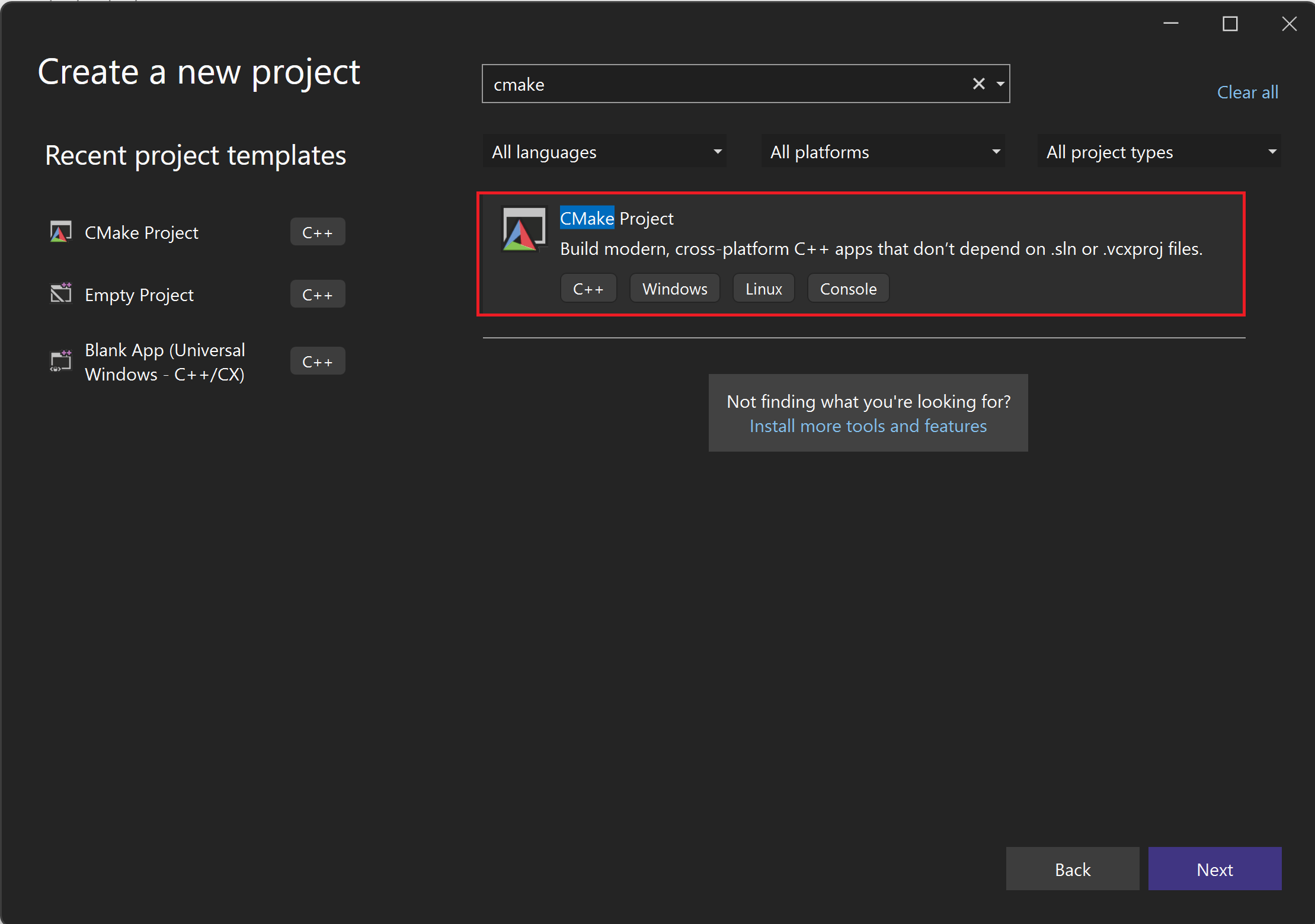
Screenshot of the Visual Studio UI for showing how to create a new CMake project in Visual Studio
- Name your project "helloworld"
- Check the box for "Place solution and project in the same directory."
- Click the "Create" button
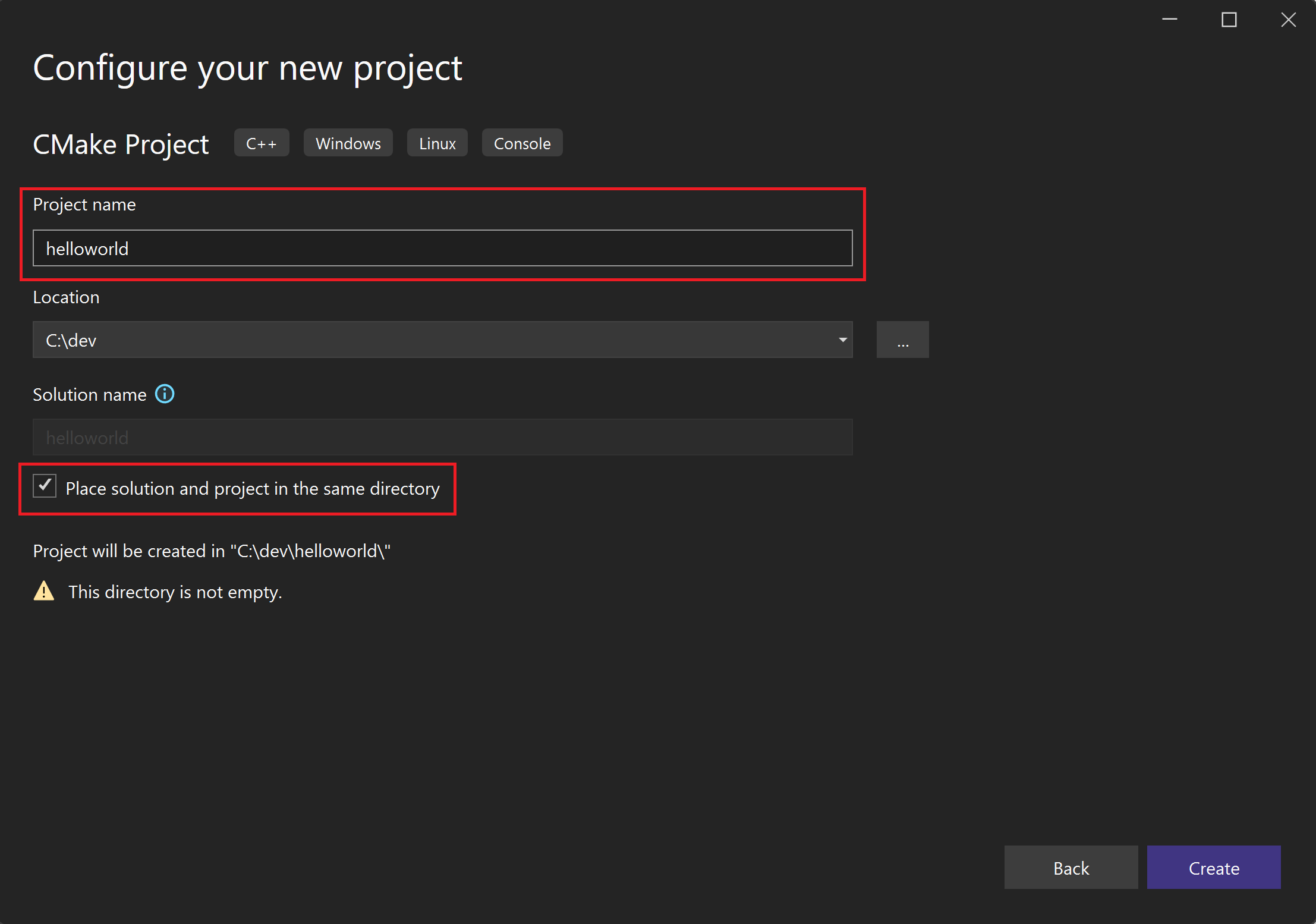
Screenshot of Visual Studio UI for naming your CMake project and clicking the "create" button.
Configure the
VCPKG_ROOTenvironment variable.Note
Setting environment variables in this manner only affects the current terminal session. To make these changes permanent across all sessions, set them through the Windows System Environment Variables panel.
Open the built-in Developer PowerShell window in Visual Studio.
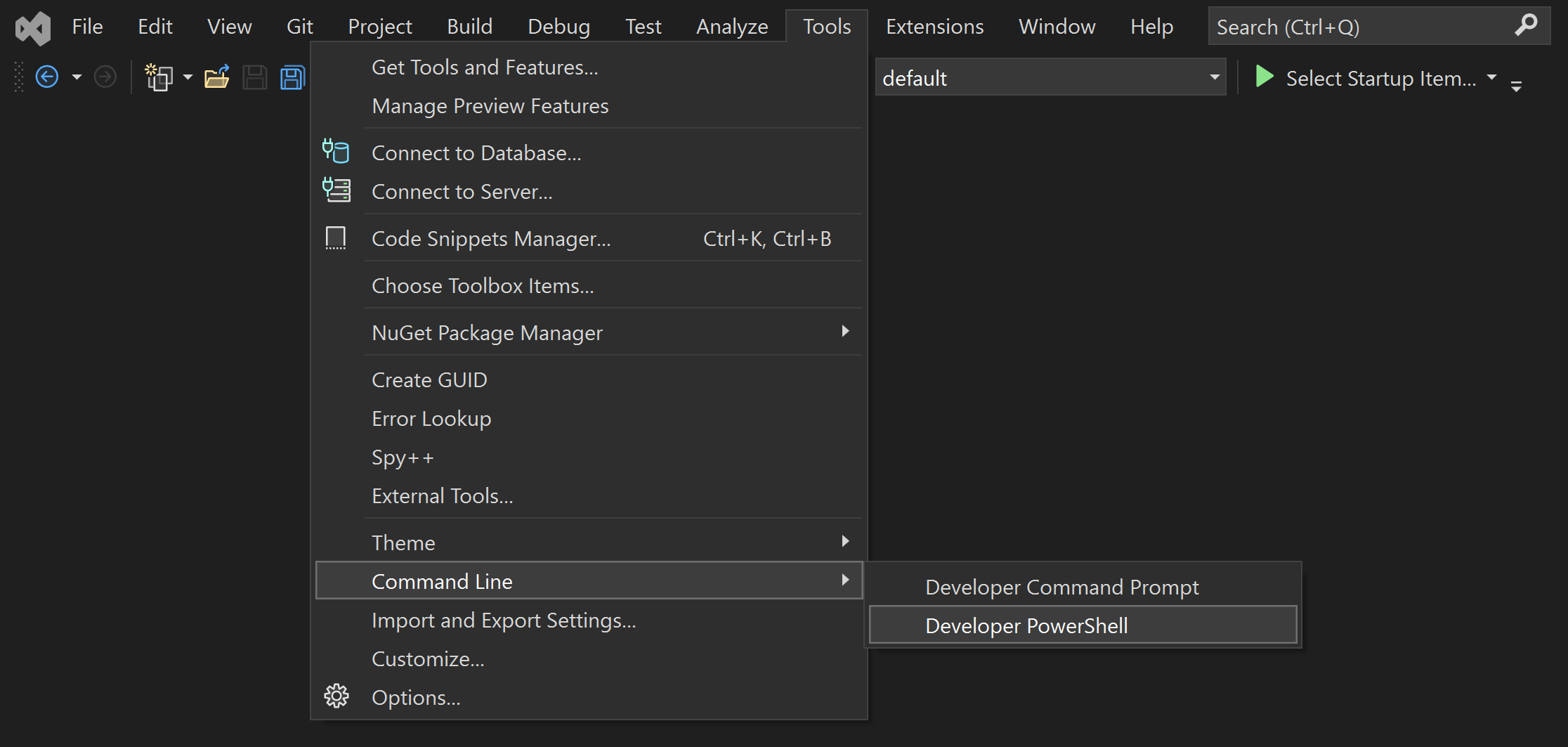
Screenshot of Visual Studio UI for the built-in PowerShell developer window
Run the following commands:
$env:VCPKG_ROOT="C:\path\to\vcpkg" $env:PATH="$env:VCPKG_ROOT;$env:PATH"
Screenshot of Visual Studio UI for the built-in PowerShell developer window showing how to set up VCPKG_ROOT and and add it to PATH.
Open the Developer command prompt in Visual Studio.
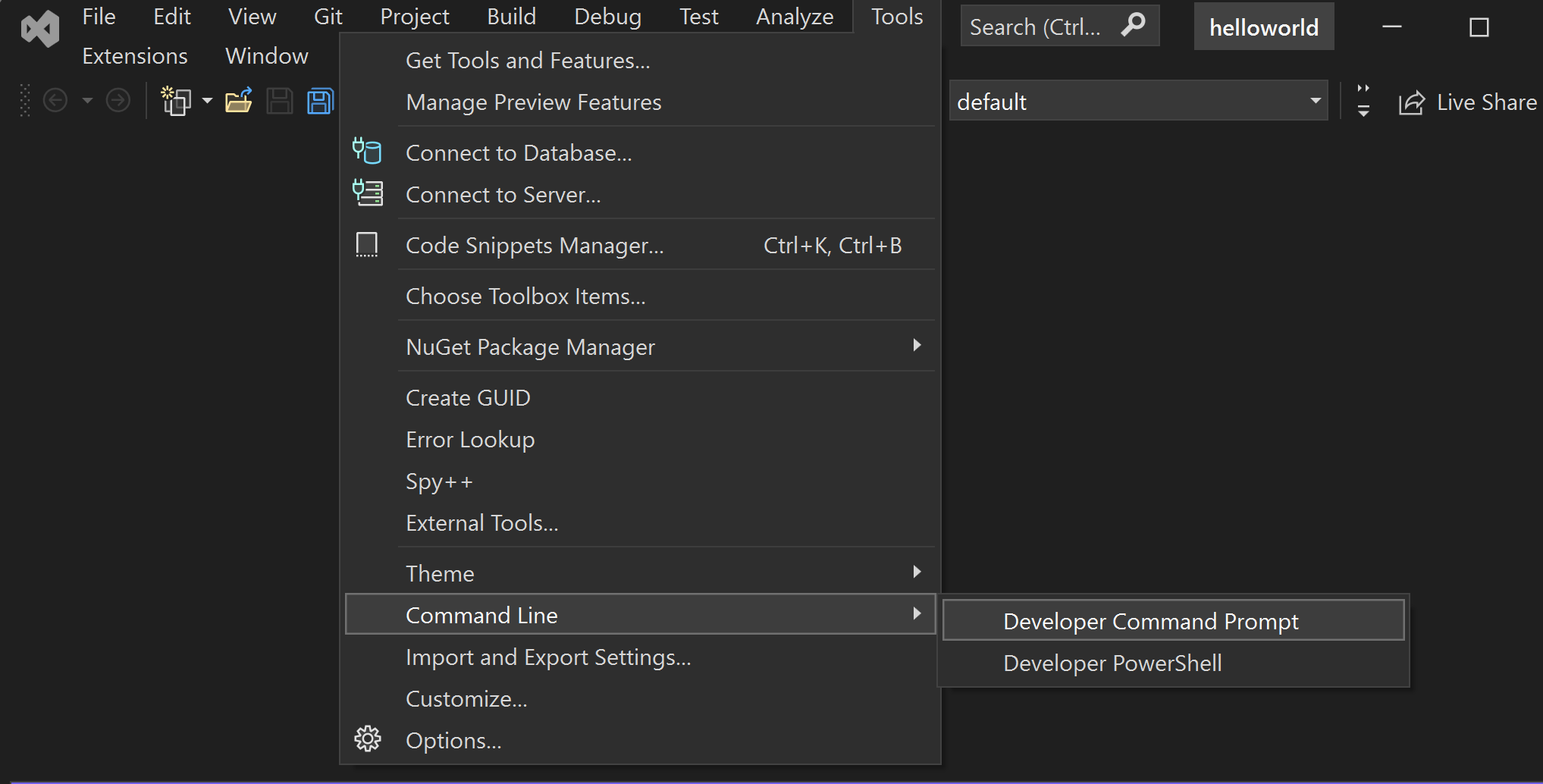
Screenshot of Visual Studio UI for developer command prompt.
Run the following commands:
set "VCPKG_ROOT=C:\path\to\vcpkg" set PATH=%VCPKG_ROOT%;%PATH%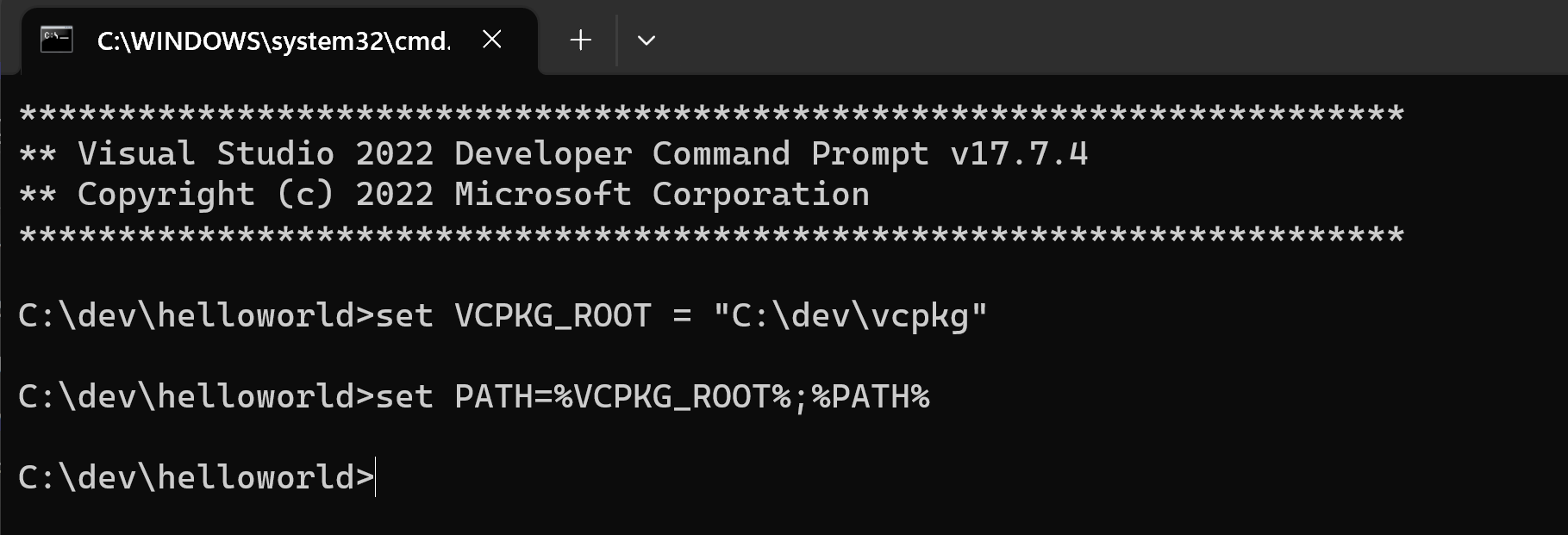
Screenshot of Visual Studio developer command prompt showing how to set up VCPKG_ROOT and and add it to PATH.
Setting
VCPKG_ROOThelps Visual Studio locate your vcpkg instance. Adding it toPATHensures you can run vcpkg commands directly from the shell.Generate a manifest file and add dependencies.
Run the following command to create a vcpkg manifest file (
vcpkg.json):vcpkg new --applicationThe
vcpkg newcommand adds avcpkg.jsonfile and avcpkg-configuration.jsonfile in the project's directory.Add the
fmtpackage as a dependency:vcpkg add port fmtYour
vcpkg.jsonshould now contain:{ "dependencies": [ "fmt" ] }This is your manifest file. vcpkg reads the manifest file to learn what dependencies to install and integrates with CMake to provide the dependencies required by your project.
The generated
vcpkg-configuration.jsonfile introduces a baseline that places minimum version constraints on the project's dependencies. Modifying this file is beyond the scope of this tutorial. While not applicable in this tutorial, it's a good practice to keep thevcpkg-configuration.jsonfile under source control to ensure version consistency across different development environments.
3 - Set up the project files
Modify the
helloworld.cppfile.Replace the content of
helloworld.cppwith the following code:#include <fmt/core.h> int main() { fmt::print("Hello World!\n"); return 0; }This source file includes the
<fmt/core.h>header which is part of thefmtlibrary. Themain()function callsfmt::print()to output the "Hello World!" message to the console.Configure the
CMakePresets.jsonfile.CMake can automatically link libraries installed by vcpkg when
CMAKE_TOOLCHAIN_FILEis set to use vcpkg's custom toolchain. This can be acomplished using CMake presets files.Modify
CMakePresets.jsonto match the content below:{ "version": 2, "configurePresets": [ { "name": "vcpkg", "generator": "Ninja", "binaryDir": "${sourceDir}/build", "cacheVariables": { "CMAKE_TOOLCHAIN_FILE": "$env{VCPKG_ROOT}/scripts/buildsystems/vcpkg.cmake" } } ] }Create
CMakeUserPresets.jsonwith the following content:{ "version": 2, "configurePresets": [ { "name": "default", "inherits": "vcpkg", "environment": { "VCPKG_ROOT": "<path to vcpkg>" } } ] }The
CMakePresets.jsonfile contains a single preset named "vcpkg", which sets theCMAKE_TOOLCHAIN_FILEvariable. TheCMakeUserPresets.jsonfile sets theVCPKG_ROOTenvironment variable to point to the absolute path containing your local installation of vcpkg. It is recommended to not checkCMakeUserPresets.jsoninto version control systems.Edit the
CMakeLists.txtfile.Replace the contents of the
CMakeLists.txtfile with the following code:cmake_minimum_required(VERSION 3.10) project(HelloWorld) find_package(fmt CONFIG REQUIRED) add_executable(HelloWorld helloworld.cpp) target_link_libraries(HelloWorld PRIVATE fmt::fmt)Now, let's break down what each line in the
CMakeLists.txtfile does:cmake_minimum_required(VERSION 3.10): Specifies that the minimum version of CMake required to build the project is 3.10. If the version of CMake installed on your system is lower than this, the build fails.project(HelloWorld): Sets the name of the project to "HelloWorld."find_package(fmt CONFIG REQUIRED): Looks for thefmtlibrary using its CMake configuration file. TheREQUIREDkeyword ensures that an error is generated if the package is not found.add_executable(HelloWorld helloworld.cpp): Adds an executable target named "HelloWorld," built from the source filehelloworld.cpp.target_link_libraries(HelloWorld PRIVATE fmt::fmt): Specifies that theHelloWorldexecutable should link against thefmtlibrary. ThePRIVATEkeyword indicates thatfmtis only needed for buildingHelloWorldand should not propagate to other dependent projects.
4 - Build and run the project
Build the project.
Press
Ctrl+Shift+Bto build the project in Visual Studio.Run the application.
Finally, run the executable:

Screenshot of Visual Studio UI for running the executable.
You should see the output:
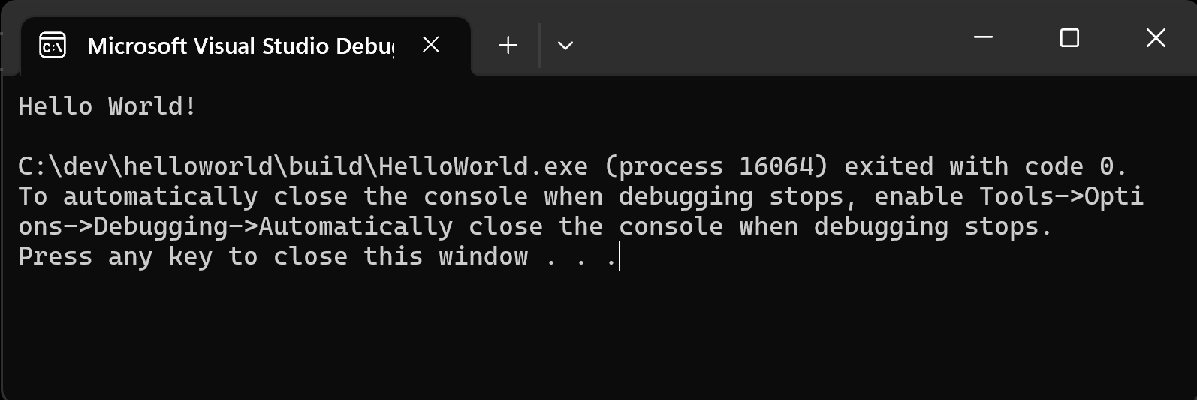
Screenshot of the program outputs - "Hello World!"
Next steps
To learn more about vcpkg.json, see our reference documentation: